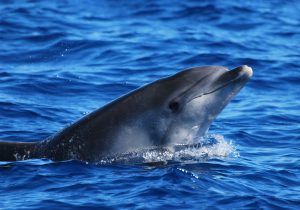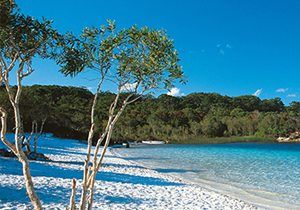NG KiDS Heads to the Galápagos Islands!
Find out all about this incredible place and the amazing animals that live there…
Giant tortoises, underwater lizards and birds with blue feet! NG KiDS heads across the Pacific Ocean to meet the amazing creatures of the Galápagos Islands…
Cruising along in our panga (a motorised dinghy), we scour the Pacific Ocean, looking for life. To our right, way in the distance, we glimpse the dorsal fin of a 15-m-long Bryde’s whale, while only metres away a pelican dives spectacularly into the sea to catch a fish. An inquisitive sea lion pops its head out of the water to size us up, then darts playfully back into the ocean, vanishing from sight. Our panguero (driver) cuts the engine and we drift slowly to shore. Carefully climbing off the boat, we set foot on a barren shingle beach. Bright red and yellow Sally Lightfoot crabs scuttle off in every direction.
“Look over there!” says our guide, naturalist Carlos King, pointing towards a huge mass of dark grey rock a couple of metres away. “What can you see?” Just rock, it would seem, ancient lava, covered with streaks of white. “Look more closely,” Carlos insists. Suddenly, the ‘rock’ twitches, then begins to crawl. In a flash, our eyes focus and we spot limbs, claws, tails and heads… hundreds of heads.
“Marine iguanas,” Carlos whispers, as one of the prehistoric-looking reptiles turns, stares at us and sneezes. An explosion of white salty snot splats on the ground near our feet. The lizard returns its attention to the mass of black and dark-grey bodies surrounding it, huddles up, closes its eyes and nods off.
Welcome to the mysterious Galápagos Islands, home to weird and wonderful creatures, many of which are found nowhere else on Earth…
Explosive Past!
The Galápagos Islands are a group of 19 islands and more than 100 islets and rocks in the Pacific Ocean, about 1,000km off the coast of Ecuador in South America. The oldest island, Española, was formed three to five million years ago, when molten rock called ‘magma’ burst through the sea bed, gradually forming a volcano that rose out of the sea.
Over the years, Española moved slowly along the Nazca tectonic plate and new islands formed on the hot spot where it had originally appeared. The Galápagos Islands are still moving today, about 6cm to the south-east every year – it’s as if they’re on a geological conveyor belt. The youngest island on the hot spot, Fernandina, is a mere 700,000 years old.
Its volcano last erupted in 2009. But in a million years time, Fernandina will itself have moved 60km southeast and new islands will have formed.
The Galápagos Islands lie on the Equator and are surrounded by different ocean currents – some warm, some cold. It’s this mix of currents that make the islands’ climate and their biodiversity (variety of species) so unique. Both cold-water and tropical creatures survive here.
Ocean Voyage!
Most of the animals and plants living on the Galápagos archipelago (group of islands) are descended from those that travelled the 1,000km from the continent of South America millions of years ago. Insects, birds and plants arrived by air – either flying or drifting in the wind, while animals floated across the ocean on rafts of leaves or branches!
And with no predators to gobble them up once they’d arrived, the creatures settled into their new home and slowly evolved (changed over time) to cope with life on the islands. The lack of predators made them unafraid of human settlers – even today, visitors to the Galápagos can get within touching distance of the wildlife, although we’re advised to keep our distance and never disturb them.
Marine Marvels!
Up to 1.5m in length (their size depends on the island they live on), the remarkable reptiles we first saw when we stepped onto Fernandina Island are the only marine lizards on the planet. When the iguanas first arrived from the mainland there was very little for them to eat, so they had to adapt to survive – and they evolved into brilliant swimmers that eat seaweed and other algae found on rocks underwater.
“Marine iguanas are unique to the Galápagos,” says Carlos. “They can stay underwater for half an hour, diving 30m down to forage for food. But because they’re cold blooded they need to warm up and regain the energy lost while diving, so they have to sunbathe afterwards.” Huddling together to conserve heat, safety in numbers also protects them from predators such as hawks while they’re slumbering in the sun. To get rid of the salt they’ve absorbed from the sea, the incredible reptiles have a simple trick up their sleeve – sneezing. Yuck!
Wild Wonders!
Marine Iguanas aren’t the only incredibly creatures that call the Galapagos home. Let’s meet some more….
Galápagos giant tortoise
The Galápagos giant tortoise is colossal, weighing up to 250kg – that’s as heavy as three men – and its shell is about 1.5m long. It can live for up to 150 years! There are two distinct types of giant tortoise in the archipelago. Those with domed shells (right) live on wetter islands, eating lush vegetation on the ground. Tortoises with saddle-shaped shells (left) that curl up at the front live on drier islands. The curve allows them to stretch their extra-long necks up to eat the leaves of tall plants. “Sadly, these wonderful creatures were hunted as food by pirates, whalers and sailors during the 17th-19th centuries, and 150,000 were killed,” says naturalist, Carlos King. Today, just 20– 25,000 remain, up to 5,000 of them in one location – the slopes of Alcedo Volcano on Isabela Island.
Galápagos penguin
Cold-loving penguins on the Equator? Yup! The second-smallest penguins in the world are also the only species found this far north. They survive here because of the mix of cool and warm currents that provide food. But these little fellas have still had to adapt to life in the Galápagos’ heat. They pant to keep cool, have really short feathers to avoid overheating, and stick to islands that have chillier water – 95% live on Isabela and Fernandina.
Scalloped hammerhead shark
The Galápagos’ seas are teeming with amazing creatures, including the bizarre-looking scalloped hammerhead shark. One of 33 shark species living in the Galápagos, this fish can grow up to 4.2m long, its eyes on the outer edge of its hammer-shaped head giving it 360-degree binocular vision! Often seen swimming in schools of over 100 sharks, these amazing fish are most likely to be spotted around the tiny islands of Wolf and Darwin, to the north west of the archipelago.
Galápagos sea lion
These cute critters love lounging around on sandy beaches, welcoming visitors to the islands with a friendly bark! Relatives of the Californian sea lion (and distant relatives of dogs!), they’re strong swimmers, sometimes travelling 15km out to sea in search of food. Pups stay in crèches, swimming and playing in shallow water until they can start fishing for themselves. And if pesky flies start ruining their afternoon siesta in the sun, they needn’t worry – hungry lava lizards will dart over and eat them off. Brilliant!
We couldn’t wait to dive in and splash about with these inquisitive creatures. Hold your breath and join us…!
Blue-footed booby
Named after the Spanish word ‘bobo’, which means ‘clown’, these birds may look funny, but there’s nothing clownish about their hunting skills. Diving into the sea from 100m above to catch fish, they hit the water at up to 100kmph! They’re noisy creatures, too. Males communicate with whistles and females honk. What a racket! Over half of the world’s blue-footed boobies live on the Galápagos – the comical birds here are a sub-species of those found on the Pacific coast of South and North America.
Did you know the creatures of the Galápagos helped change the way people thought about the world?! Find out how in our fab feature Charles Darwin and the Mystery of Life!
Video: ©Vincenzo Chiarello
Main tortoise and camouflaged iguanas: ©Tim Herbert
All other images: Getty Images UK
More Like Countries

Escape to the Azores with Activities Abroad

Experience life as an animal with virtual-reality headsets!

USA facts: get ready for the lowdown on the Land of Opportunity!


















LEAVE A COMMENT
THANK YOU
Your comment will be checked and approved shortly.
WELL DONE,
YOUR COMMENT
HAS BEEN ADDED!
COMMENTS
I have to do a speech on the Galapagos Islands.
Intresting
cool!
It's crazy that penguins live in the Galápagos Islands!
I think its amazing when you went underwater with the sea lions. WOW!!!
all these animals are so cool
Galapagos tortoise for life!!!!!!!!!!!!!!!!!!!!!!!!!!!!!!!!!!!!!!!!!!!!!!!!!!!!!!!!!!!!!!!!!!!!!!!!!!!!!!!!!!!!!!!!!!!!!!!!!!!!!!!!!!!!!!!!!!!!!!!!!!!!!!!!!!!!!!!!!!!!!!!!!!!!!!!!!!!!!!!!!!!!!!!!!!!!!!!!!!!!!!!!!!!!!!!!!!!!!!!!!!!!!!!!!!!!!!!!!!!!!!!!!!!!!!!!
Gld
wow!
amazing animals and awesomeness
amazing!!!!!!
I like nature documentaries and have seen a few on these islands and i am subscribed to a magazine called How It Works (I highly recommend it) and the latest issue features an article about them. They look incredible!
I heard about the Galapagos Island in my science teachers room at 7th grade too.
Cool!
its cool xd i love this web
Awesome! That helped me a bit with my homework Thanks!
Wow! I really want to go there now! I loved the blue footed booby. It was so comical but awesome. By the way, Ng kids has inspired me to be a zoologist when Im older!
CUSTOMIZE YOUR AVATAR